A Geographical, Historical, and Political Description of the Empire of Germany [*]
Chap. III. Population, Language, Commerce, Universities, Arts, Sciences; — Chap. IV. Form of Government and Religions; — Chap. V. Division of the Country; — Chap. VII. The Circle of Bavaria (with Munich, Caroline’s final residence); — Chap. VIII. The Circle of Swabia (where Caroline died; Schelling’s home); — Chap. IX. The Circle of the Franconia (Bamberg, Auguste’s death in Bocklet, Caroline in Würzburg); — Chap. XI. The Circle of the Lower Rhine (Caroline in Mainz); — Chap. XIV. The Circle of Lower Saxony (Caroline in Göttingen, Clausthal, Braunschweig); — Chap. XV. The Circle of Upper Saxony (Caroline in Gotha, Jena, Dresden)
Chap. III.
Population — Language — Commerce
Universities — Arts — Sciences, &c.
The number of inhabitants in Germany is estimated at 24,000,000. They speak two principal languages, the German and Sclavonian. The German has two chief dialects; the High Dutch [Deutsch], which is spoken in the southern, and Low Dutch [Deutsch], in the northern part of Germany. The Sclavonian is spoken in many dialects in the interior of Austria, Moravia, Bohemia, Lusatia; and Italian and French on the borders of those countries.
The German artists and handicraftsmen manufacture all the necessaries and luxuries of life; and the demand for English and French goods, which was formerly very great, is upon the decrease. Many articles of German manufacture, particularly linen cloth, are exported to foreign countries. The great number of navigable rivers is favourable to the inland commerce: besides, Germany trades by land with all the neighbouring countries, and by sea with almost all the European states, and likewise to the East Indies [Footnote: The most noted trading towns are, Hamburg, Lubeck, Bremen, Ostend, Stettin on the North and Baltic seas; Fiume and Triest, on the Adriatic Sea; and in the interior of the country, Frankfort on the Mayn, Leipzig, Brunswick, Frankfort on the Oder, Nuremburg, Mentz (Mainz); these six last have very great annual fairs, at which the barter or exchange of books forms no inconsiderable part of the traffic.] The arts and sciences are held in great estimation by the Germans: the world is indebted to their inquisitive spirit and persevering diligence for many useful discoveries and inventions therein.
Germany contains thirty-seven universities, sixteen of which are Catholic [Footnote: Vienna, Grätz, Bamberg, Würtzburg, Ingolstadt, Saltzburg, Mentz, Cologne, Triers, Freyberg, Dillingen, Fulda, Prague, Breslaw, Olmütz, and Löwen], seventeen Lutheran [Footnote: Göttingen, Leipzig, Halle, Wittenberg, Jena, Erfurt, Erlangen, Giessen, Greifswalde, Helmstädt, Kiel, Rinteln, Rostock, Tübingen, Büzow, Altorf, Stutgard] and four reformed [Footnote: Duisburg, Frankfort on the Oder, Heidelberg, and Marburg. — Note: Erfurt and Heidelberg are mixed universities; for Erfurt has Lutheran and Catholic, and Heidelberg Catholic and Calvinist professors]. At Vienna and Berlin are academies for painting, sculpture, and architecture; at Berlin an academy of sciences; at Dresden and Nuremberg academies for painting; at Munich an academy of the belles lettres; and at Augsburg an academy of the liberal arts.
Chap. IV.
Form of Government and Religions
The German empire [Holy Roman Empire of the German Nation] comprises about 300 states, large and small, united together under one head. Almost all have a monarchical form of government (the free Imperial cities excepted, wherein the government is either aristocratical or democratical), and are partly subject to temporal, partly to ecclesiastical princes and lords. One of the temporal princes enjoys the rank of king, namely, King of Bohemia. The rest are dukes, landgraves, margraves, princes, counts, &c. The ecclesiastical princes are, archbishops, bishops, provosts, and abbots. As the different states of the Empire compose one general body, so likewise they have one general government, and one common head, namely, the German or Roman Emperor. He is chosen from amongst their own number by the most powerful princes of the Empire, in whom is vested decisively the right of electing him, and who are thence called Electors. At present there are eight electors, three ecclesiastical and five temporal. The ecclesiastical are, the three archbishops of Mentz [Mainz], Triers, and Cologne; and the temporal, the King of Bohemia, the Count Palatine of the Rhine and Duke of Bavaria, the Duke of Saxony of the house of Albert, the Margrave of Brandenburg of the elder branch, and the Duke of Brunswick Lunenburg.
Germany has been an elective monarchy ever since the time of the Emperor Arnulph in 887. Before that period, not only the higher, but likewise the lower classes of the nobility voted at an election. In process of time the lower orders of nobility were excluded, and at length the right of election centred in the seven chief princes, who are invested with the arch offices of the Imperial court, and was confirmed to them by the Golden Bull. The following is the ceremony used at the election and coronation of an emperor: The Elector of Mentz, within a month after the death of an emperor, acquaints the other electors with the circumstance, in a circular letter, by a special messenger, and appoints a day, within three months, for a new election at Frankfort on the Mayn, which is the usual place, although any other city may be fixed upon for that purpose, with the concurrence of the electors. They are not obliged to appear personally, but are allowed to appoint deputies. Should the archbishopric of a spiritual elector be vacant at the time, the chapter cannot vote at the election. If a temporal elector should happen to be a minor, the nearest relation officiates for him. . . . [1]
The Emperor cannot increase the number of electors at pleasure; but the concurrence of the states of the Empire is requisite for that purpose. On the other hand, he can grant titles and arms to dukes, princes, counts, barons, noblemen, and pfalzgraves. He confirms the universities of the Empire in their privileges. He gives fiefs, and decides all disputes concerning precedence among the states. In the Imperial chamber he nominates the judge and the presidents; but the Aulic council is entirely of his appointment.
The Imperial title is, By the grace of God Roman Emperor elect, at all times Augmenter of the Empire, King in Germany. If during an emperor’s life-time a successor be chosen, he is called King of the Romans, at all times Augmenter of the Empire, King in Germany. He is chosen and crowned in the same manner as the Emperor of the Romans, and immediately upon the decease of his predecessor is invested with the Imperial title and power. If an emperor should die before his successor is appointed, the Electors of Bavaria and Saxony supply his place, under the title of Regents of the Empire, till a new emperor is chosen.
The government of the German Empire, as a state composed of many states united, is vested in the Emperor of Germany and the sovereigns of each separate state, who are called independent members or states of the Empire. For that purpose an Imperial convocation is summoned, called a diet.
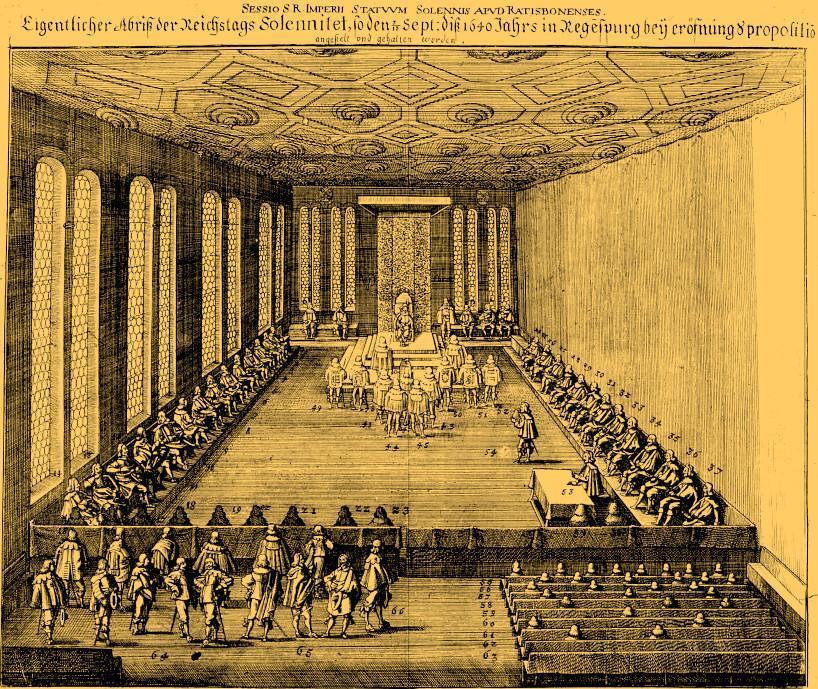
Formerly it was appointed by the Emperor, sometimes in one and sometimes in another Imperial city, and the emperors and sovereigns generally appeared in person. At present, as the diet has lasted since 1663 without intermission or any fresh summons [i.e., perpetually], the business is transacted by means of deputies from the Emperor and states.

The states are divided at the diet into three grand divisions, or so called Imperial Colleges. The first Imperial college, which is called the electoral one, is composed of electors. Besides the above-mentioned right of choosing an emperor, the electors have likewise many privileges which every emperor is obliged to confirm to them, together with the electoral dignity, upon his accession. Besides this, each elector holds an office which he performs by deputy, at the election of an emperor, and on other occasions. Those territories which give their possessors the dignity of electors are indivisible, and descend to the eldest son, who is of age at eighteen, In the College of Electors every one has a vote, and the Elector of Mentz acts as president. The second Imperial college, which is called the Princely, consists, 1st, of the princes of the Empire; 2dly, of the Imperial prelates; and 3dly, of the Imperial counts and lords. The princes of the Empire are sixty-one temporal, and thirty-three ecclesiastical, each of whom has a vote [Footnote:The temporal princes of the Empire consist of dukes (one of whom is an archduke), palatines, margraves, landgraves, princes, and counts with the rank of princes. The ecclesiastical princes of the Empire are archbishops, bishops, abbots, and provosts, with the dignity of princes]. The Imperial prelates [Footnote: The Imperial prelates are abbots, provosts, and abbesses] are divided into the Swabian and Rhenish benches; each bench has only one vote. The Imperial counts and lords are divided into four colleges, the Wetteravian, Franconian, Swabian, and Westphalian, and have all together only four votes. In this college the Archduke of Austria and Archbishop of Saltzburg preside by turns. The third Imperial college, which is that of the cities, is composed of fifty Cities, who are independent except of the Emperor, and are thence called free Imperial Cities. Their deputies sit on two benches, fourteen on the Rhenish, and thirty-seven on the Swabian. That city in which the diet is held takes the lead. In comparison with this third Imperial college the other two are called the Upper Colleges. Each of these three Imperial colleges assembles separately, and their decisions are carried by majority of votes. A decree of all three colleges is called an Imperial resolution, and when ratified by the Emperor, an Imperial decree.
Besides the Imperial princes and counts, there are several princes and a great number of counts in Germany, who are not states of the Empire, and have neither seat nor vote at the diet. The rest of the German nobility consist of barons and knights, or noblemen. In some of the Imperial cities since the twelfth century, several families have been raised to a kind of nobility, and to a certain pre-eminence in the government of the city: these are called patricians.
The principal courts of justice are the Imperial Aulic council, and the Imperial and [?] chamber of the Empire. The Imperial Aulic council is held in the Emperor’s palace, and is dependant on him alone. The Imperial chamber is appointed by the Emperor and states of the Empire conjointly, but held alone by the latter generally in the Imperial city of Wetzlar.
An emperor of Germany possesses in quality of Emperor no territories whatever in Germany, and but small revenues. But the present Imperial family is rich and powerful, being possessed of extensive hereditary dominions. The Imperial revenues are partly ordinary and continual, partly extraordinary. The ordinary ones are expended in the support of the Imperial chamber. The extraordinary are collected by contributions from each state, and, together with the so called Roman months [Footnote: The name of Roman months originated in those times when the emperors went to Rome to perform the ceremony of crowning the popes, and the states were obliged to furnish, at their own expence for six months, a certain number of horse and foot to accompany him, or pay instead of every horseman twelve gulden and for each foot soldier four gulden], appropriated to carry on wars and other exigences. The army of the Empire must likewise be furnished by the states, and since 1702 consists in times of peace of 80,000, and in war of 120,000 men. The Imperial arms are a black eagle, with two heads and extended wings, in a field or [?], and the Imperial crown over the heads of the eagle.
The principal religious in Germany are the Catholic and Protestant. The members of both, since the peace of Westphalia in 1648, enjoy equal rights and privileges. The Roman Catholics acknowledge the supremacy of the Pope in spiritual and ecclesiastical matters; but his authority is very much circumscribed in many Provinces. The principal clergy of that religion are seven archbishops [Footnote: The archbishops of Mentz, Triers, Cologne, Saltzburg, Vienna, Prague, and Görz], and a great number of bishops, abbots, and provosts, many of whom are princes of the Empire. Amongst the Protestants, who are divided into Lutherans and Calvinists, the sovereign has the chief power in spiritual affairs, which he delegates to certain colleges appointed by him, called consistories. The chief of the Lutheran clergy are, general superintendants, superintendants, inspectors, provosts, &c.: amongst the Calvinists; deacons, presbyters, inspectors, and provosts. To the Protestants belong likewise the Evangelical Brethren, who adhere to the Augsburg confession, but have their own peculiar church regulations. Other religious sects enjoy liberty of conscience here and there. Many thousand Jews are likewise tolerated throughout the Empire.
Chap. V.
Division of the Country


I. On the Danube to the south:
1. Austria,
2. Bavaria,
3. Swabia.
II. In the heart of the country, on the Mayn:
4. Franconia.
III. On the Rhine to the west:
5. Upper Rhine,
6. Lower Rhine.
7. Westphalia.
IV. To the west on the Maas:
8. The circle of Burgundy, or the Austrian Netherlands.
V. To the north on the Elbe:
9. Lower Saxony,
10. Upper Saxony.
The following countries belong likewise to Germany: the kingdom of Bohemia; the margavate of Moravia; the margavates of upper and Lower Lusatia; the dutchy of Silesia; the several small districts and places lying in the ten circles, but not reckoned to belong to any of the ten.
Chap. VII.
The Circle of Bavaria
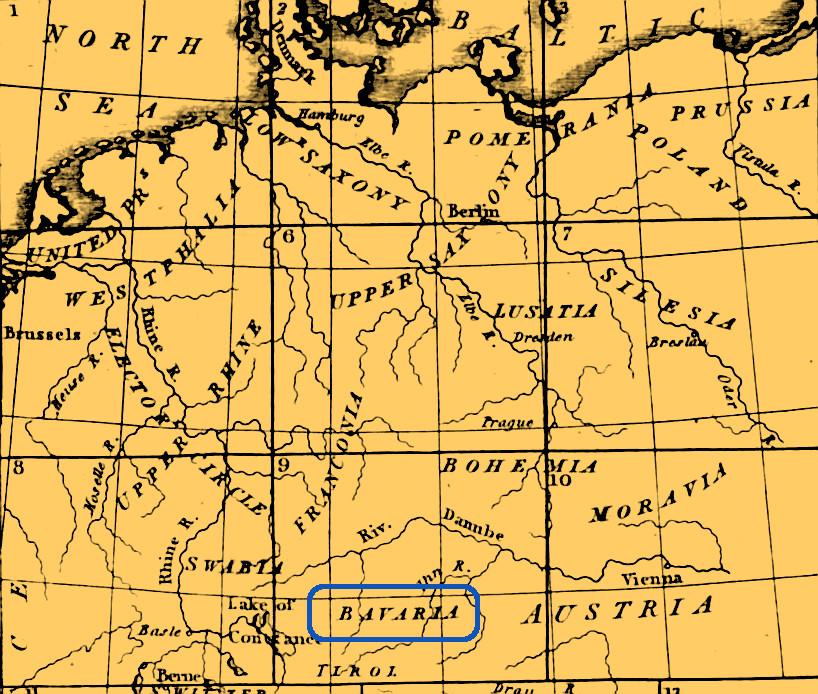

It lies north-west of the circle of Austria, on the Danube. The most considerable rivers next to the Danube and Inn are, the Nab and the Iser, both of which run into the Danube. Most of the inhabitants, as well as their sovereigns, are Catholics. In the Upper Palatinate, and in the free Imperial city of Ratisbon, there are likewise Lutherans and Calvinists; and in the county of Ortenburg the inhabitants and the sovereigns are entirely Lutheran. The directing princes of this circle are the Elector of Bavaria and the Archbishop of Salzburg. The assemblies of the circle are commonly held at Ratisbon or at Wasserburg. The following districts and states belong to the circle of Bavaria:
I. The territories of the Elector Palatine of Bavaria. They comprehend the greatest part of the circle of Bavaria, have a fine breed of cattle, much wood, and produce a great deal of corn, likewise silver, copper, lead, salt, and are as follow:
1. The dutchy of Bavaria on the Danube and Iser, is divided into Upper and Lower Bavaria, and comprises the greatest part of the circle of Bavaria. The principal places in Upper Bavaria are,
Munich, on the Iser, the capital of all Bavaria, and residence of the elector. It is one of the finest towns in Germany, and contains upwards of 50,000 inhabitants. Ingolstadt, a fortified town on the Danube, with an university. Donauwerth, on the Danube. Landshut is the capital of Lower Bavaria.
2. The Upper Palatinate, to the north of the dutchy of Bavaria, of which Amberg is the capital.
3. The principalities of Neuburg and Sulzbach. They lie for the greatest part in the Upper Palatinate. The chief towns are, Neuburg and Sulzbach.
4. The princely county of Leuchtenburg, in the Upper Palatinate.
5. The county of Haag, between Upper and Lower Bavaria.
6. The lordships of Ehrenfels, Sülzburg and Pyrbaum, and Breiteneck, in the Upper Palatinate, and the lordship of Hohenwaldeck, in Upper Bavaria.
II. The archbishopric of Salzburg, a very mountainous country, has a fine breed of horses, and yields many kinds of minerals.
[footnote: Salzburg has been an archbishopric ever since the eighth century. The archbishop is the sovereign. His revenues are estimated at three millions of dollars, or 525,000. sterling.]
Salzburg, the capital and residence of the archbishop, has an University. Hallein, a town with a considerable salt-mine.
III. Three bishoprics [footnote: They were established in the eighth century. The bishops are sovereigns of their respective territories, and princes of the Empire.]:
1. The bishopric of Ratisbon, on the Danube.
2. The bishopric of Passau, on the Danube, to the east of Ratisbon. Passau, at the conflux of the Inn and Danube, is the capital and residence of the bishop.
3. The bishopric of Freysing, on the Iser, to the south of Ratisbon, in which lies Freysing, near the Iser, the capital and episcopal residence.
lV. The princely provostship of Berchtesgaden, between Lower Bavaria and the archbishopric of Salzburg. The provost, who is a prince of the Empire, is the sovereign.
V. The princely county of Sternstein. It lies in the Upper Palatinate, and belongs to Prince Lobkowitz.
VI. The county of Ortenburg, in Lower Bavaria, belongs to the Count of Ortenburg.
VII. The free Imperial city of Ratisbon. It lies on the Danube; the magistracy and most of the inhabitants are Calvinists. The diets have been held here since 1663. Besides the bishop of Ratisbon, who always resides here, this city is likewise the residence of three other princes of the Empire; namely, the abbot of St. Emmeram, at the monastery of the same name, and the abbesses of Upper and Lower Münster, at the two nunneries. These three princely abbies are possessed of considerable property.
Chap. VIII.
The Circle of Swabia


It lies to the west of the circle of Bavaria, on the Danube, the Neckar, and the Lech. The Neckar rises in this circle in the dutchy of Würtemberg, and falls into the Rhine. The Lech takes its rise in Tyrol, runs along the borders of Bavaria and Swabia, and falls into the Danube. The country produces much corn, fruit, wine, and likewise metals. In Würtemberg, Baaden, and many free Imperial cities, the greatest part of the inhabitants are Lutherans or Calvinists, but in the other states chiefly Catholics. In Würtemberg the Waldenses are likewise permitted the free exercise of their religion. The directorial princes of this circle are, the Bishop of Constance and the Duke of Würtemberg. The circular assemblies are commonly held at Ulm. The following territories and cities belong to this circle:
I. The countries of the temporal princes.
1. The dutchy of Würtemberg, on the Neckar, one of the most fertile countries in Germany in corn, wine, and fruits; with the county of Justingen, which is enclosed within the dutchy of Würtemberg (W. R. Shepherd, Historical Map of Central Europe about 1786 [1926]):

The chief towns are,
Stutgard, the capital and residence of the duke, near the Neckar. It has an university, and contains upwards of 18,000 inhabitants. Tübingen, a town on the Neckar, with an university. Ludwigsburg, which the duke usually makes his summer residence.
2. The margravate of Baaden, with the county of Eberstein. The former lies straggling along the Rhine to the south-west of Würtemberg, and produces much corn and good wine. It is divided into the upper and lower margravate. In the latter is produced the so called Margravate wine, which is of a very excellent quality. Eberstein borders on the lower margravate. The sovereign is the Margrave of Baaden. The chief towns in Baaden are, Durlach, the capital. Carlsruhe, the residence of the margraves. Rastatt, a town of note, on account of the peace concluded there in 1714. An ineffectual attempt to the same purpose was made at this place by the congress of the ambassadors of the belligerent powers, in 1798 and 1799, the termination of which is marked by the massacre of two of the French deputies, the odium of which the remaining one (Jean Debry) endeavoured to throw upon the Austrian government, although it has since been ascertained that himself was the instigator of that horrid transaction. Baaden, a town with warm baths, which gives name to the whole margravate.
3. The territories of the princes of Hohenzollern. They lie scattered between the Danube and Neckar, and comprehend the princely county of Hohenzollern, the counties of Sigmaringen and Vöringen, and the lordship of Haigerloch. The princes of Hohenzollern are divided into the branches of Hechingen and Sigmaringen.
Hechingen and Sigmaringen are the residences of their respective princes.
4. The territories of the Prince of Fürstenberg. They consist of the county of Heiligenberg, with the lordships of Jungnau and Trochtelfingen. the landgravate of Stühlingen and Baar, and the lordships of Hausen, in the valley of Kinzing, Moskirch, and Gundelfingen, which lie scattered on both sides of the Danube.
The small town of Doneschingen is the residence of the prince.
5. The county of Oettingen. It lies on the borders of Franconia and Bavaria, and belongs to the house of Oettingen, which is divided into three branches, the princes of Oettingen-Spielberg and Oettingen-Waldeck, and the counts of Oettingen-Baldern.
Oettingen is the capital and residence of the princes of Oettingen-Spielberg.
6. The principality of Lichtenstein. It includes the lordships of Vaduz and Schellenberg, which lie on the Rhine to the west of the lake of Constance, and is subject to the princes of Lichtenstein.
7. The landgravate of Kletgau, on the Rhine. It borders on Switzerland, and belongs to the Prince of Schwarzenberg.
8. The princely county of Thengen, to the north-east of Kletgau. The Prince of Auersperg is the sovereign.
II. Territories of the ecclesiastical princes.
1. The bishopric of Constance, on the lake of that name.
Mersburg or Mörsburg, a town on the lake of Constance, is the residence of the bishop.
2. The bishopric of Augsburg lies scattered between the Danube and the Lech.
Dillingen, a town with an University, is the residence of the bishop.
3. The princely provostship of Elwangen, on the borders of Franconia.
4. The princely abbey of Kempten, to the west of the bishopric of Augsburg.
III. Estates and territories of prelates. The following twenty-one abbies possess considerable property, and some of them extensive territories . . . The abbots and abbesses are sovereigns of all these territories in quality of independent prelates of the Empire.
IV. Several small counties and lordships.
1. The countries subject to the hereditary Imperial stewards or counts of Waldburg. These comprehend several counties and lordships to the west of the princely abbey of Kempten.
2. The territories of the counts of Königsegg. They lie on the borders of Tyrol,
and include two counties and a lordship.
3. The territories of the Counts Fugger, comprehending a number of lordships lying scattered between the Danube and Lech.
4. The county of Hohenembs, to the south-east of the Lake of Constance, on the Rhine. It belongs to the House of Austria.
5. The county of Bondorf borders on the landgravates of Stühlingen and Baar, and belongs to the abbey of St. Blase.
6. The county of Hohengeroldeck borders on Austrian Brisgau, and is governed by Counts.
7. The lordships of Wiesensteig, Mindelheim, and Schwabeck. The first lies between the dutchy of Würtemberg and the territory of Ulm, and the two latter border on the bishopric of Augsburg. They belong to the electors Palatine of Bavaria.
8. The lordships of Tettnang and Argen, on the Lake of Constance. The counts of Montfort are the sovereigns.
9. The lordship of Eglof, to the east of the former, subject to the counts of Traun and Abensperg.
10. The lordships of Thaunhausen and Eglingen, to the south of the county of Oettingen. The former belongs to the counts of Stadion, the latter to the Prince of Turn and Taxis.
V. Thirty-one free Imperial Cities, many of which possess considerable territories.
1. Augsburg, a city near the Lech. It contains 36,000 inhabitants, mostly Lutherans, and many very expert artists. The Protestant confession of faith was drawn up here at the diet in 1530, and thence called the Augsburg Confession. 2. Ulm, on the Danube, possesses a very extensive tcrritory. 3. Esslingen, on the Neckar. 4. Reutlingen, near the Neckar. 5. Nördlingen, in the county of Oettingen. 6. Swabian Hall, on the borders of Franconia, has considerable salt-springs, and a large territory. 7. Heilbrunn, on the Neckar. 8. Memmingen, to the south-east of Ulm, carries on a great trade. 9. Lindau, on an island in the Lake of Constance. In this city is the princely abbey of Lindau, whose abbess is a princess of the Empire. 10. Kempten, to the north-east of Memmingen. 11. Ysni or Isni, south-west of Kempten. 12. Leutkirch, west of Kempten. 13. Gingen, north-east of Ulm. 14. Buchhorn, on the Lake of Constance. 15. Aalen, south of Elwangen. 16. Bopfingen, east of Aalen. 17. Ueberlingen, on the Lake of Constance. 18. Rothweil, on the Neckar. 19. Gemünd, west of Aalen. 20. Weil or Weilerstadt, in the dutchy of Würtemberg. 21. Wangen, to the north of the Lake of Constance. 22. Pfullendorff, near the Danube. 23. Offenburg, near the Rhine. 24. Zell, on the Hammersbach, to the east of Offenburg. 25. Buchau, on the Feder lake, near the Danube, In this city is the princely abbey of Buchau, whose abbess is a princess of the Empire. 26. Dinkelspühl, on the borders of Franconia. 27. Biberach, to the south of Ulm, north-west of Wangen. 28. Ravensburg, to the north of the Lake of Constance. 29. Kaufbeuren, south of Augsburg. 30. Wimpfen, on the Neckar. 31. Gengenbach, between Offenburg and Zell. [Footnote: The inhabitants of the cities from No. 1 to 16 are chiefly Protestants; from 17 to 25 mostly Catholics; and from 26 to 31 the Protestants and Catholics have equal privileges.]
Chap. IX.
The Circle of Franconia.

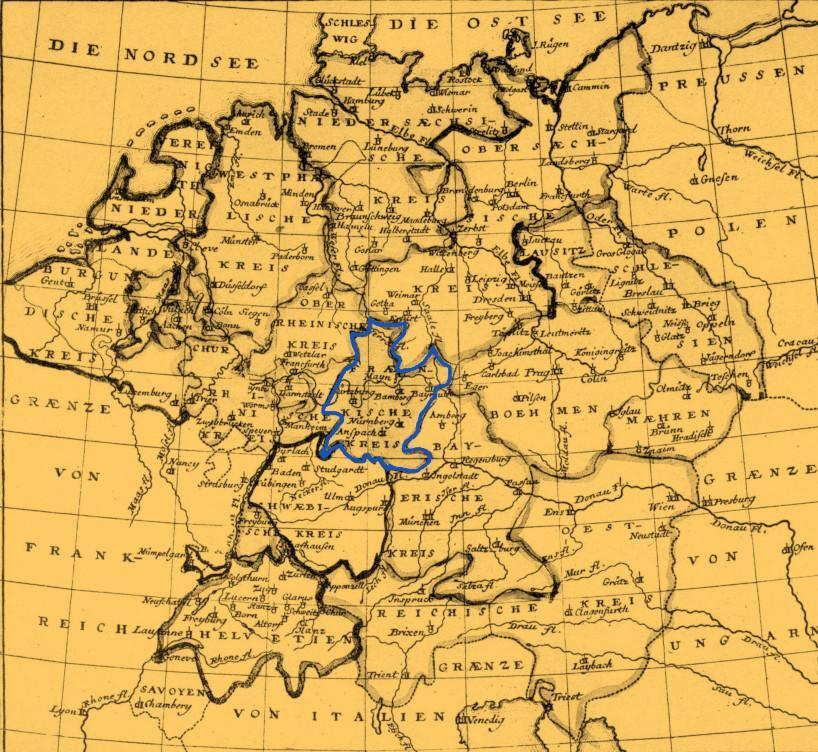
It lies to the north of Swabia, on the Mayn, which rises in the principality of Bayreuth, and falls into the Rhine. The country is mountainous, very fertile in corn and wine, has good breeds of cattle, with much wood and fruit. The inhabitants are partly Catholics, partly Lutherans [Footnote: Catholics in Bamberg, Würzburg, and Eichstett, and partly so in Henneberg and Schwarzenberg, and in some of the lordships; in the other states, and in the free Imperial cities, they are Lutherans.]. There are also some Calvinists here and there. The directing princes of the circle are the Bishop of Bamberg and the Margrave of Anspach and Bayreuth. The circular assemblies are held at Nürnberg. The following countries belong to this circle:
I. The territories of the ecclesiastical princes:
1. The bishopric of Würzburg, in the middle of the country. It produces very good Franconian wine.
Würzburg, the capital, on the Mayn, has a Catholic University.
2. The bishopric of Bamberg, to the east of the former, on the Mayn; a very fertile country in fruits, corn, and wine, wherein lies
Bamberg, the capital, with a Catholic University.
3. The bishopric of Eichstett, on the borders of Bavaria.
Eichstett, or Aichstädt, is the capital.
4. The mastership of Mergentheim and the bailiwick of Franconia, belonging to the Teutonic knights. It lies to the south of Würzburg.
The small town of Mergentheim is the seat of the grand master.
[Footnote: The order of Teutonic knights was instituted on occasion of the crusades in Palestine in 1190. The duties of the knights of this order were, the propagation of the Christian religion, and the care of the poor and sick in the Holy Land. They must be Germans, descended from noble families. The chief of the order, the Grand or Teutonic matter, at first resided at Jerusalem, then at Venice, afterwards at Marburg, and then at Marienburg in Prussia; but since the sixteenth century at Mergentheim. Besides the mastership of Mergentheim and the bailiwick of Franconia, the Teutonic order possesses eleven bailiwicks or provinces in Germany, France, and the Netherlands, which are called after those countries and cities in which they are situated; namely, the bailiwick of Alsace and Burgundy; the bailiwick of Austria; the bailiwick on the Etsch and in the mountains of Tyrol; the bailiwick of Coblentz; the bailiwick of Altenbisen, partly in Germany, partly in the Netherlands; the bailiwick of Westphalia; the bailiwick of Lorrain; the bailiwick of Hesse; the bailiwick of Saxony; the bailiwick of Thuringia; and the bailiwick of Utrecht. The estates belonging to each bailiwick are divided into commanderies, the head of which are called commanders. The grand master is an ecclesiastical prince. The knights are partly Catholics, partly Lutherans.]
II. The dominions of the Margrave of Brandenburg-Anspach and Bayreuth.
[Footnote: The principalities of Anspach and Bayreuth comprehend the ancient burgravate of Nürnberg, established in the twelfth century, in which also it devolved to the counts of Zollern. After the burgraves of Nürnberg had obtained the electorate of Brandenburg in the fifteenth century, they styled themselves Margraves of Brandenburg. From that æra both principalities have at times had the same sovereign as the margravate of Brandenburg. Since the year 1603 they have been governed by two branches of the electoral family of Brandenburg, the eldest of which became extinct in 1768 upon the decease of the last Margrave of Brandenburg-Bayreuth. At present the Margrave of Brandenburg-Anspach is in possession of both principalities, and is styled Margrave of Brandenburg-Anspach and Bayreuth.]
1. The principality of Anspach or Onolzbach, south of Würzburg and Bamberg. The chief places are,
Anspach, the capital and residence of the margrave; having a porcelain manufactory. Fürth, a small place, inhabited by a great number of artists and handicraftsmen.
2. The principality of Bayreuth or Culmbach, to the east of Bamberg. In this principality is the Fichtelberg, which gives rise to the Mayn, the Saale, and Eger. The principal places are,
Bayreuth, the capital; Culmbach, a town on the Mayn; Erlangen, a town with a Lutheran University.
III. The princely county of Henneberg, to the north of Würzburg, on the Werra. It belongs partly to the Elector of Saxony, partly to the dukes of Saxe-Weimar, Meinungen, Gotha, Coburg, and Hildburghausen; and partly to the Landgrave of Hesse Cassel. The chief towns are,
Smalkald, a town in the division of Hesse Cassel, famous for the treaty concluded
there in 1531 by the Protestant princes; Schleusingen, a town in the Elector of Saxony’s part, the residence of the electoral overseer; Suhla, a town in the same division, with famous iron and steel manufactures ; Meinungen, the residence of the Duke of Saxe-Meinungen.
IV. The principality of Hohenlohe, to the west of Anspach, on the borders of Swabia.
Oehringen is the capital.
V. The princely county of Schwarzenberg, between Würzburg, Bamberg, and Anspach, with the lordship of Seinsheim, in the principality of Anspach.
Schwarzenberg is the residence of the prince.
VI. Four counties:
1. Castell lies scattered between Bamberg and Würzburg, but chiefly in the latter.
2. Wertheim, to the west of Würzburg, on the Mayn, produces a great quantity of wine.
Wertheim, on the Mayn, is the capital.
3. Rieneck to the north of Wertheim, on the Mayn.
4. Erbach, west of Wertheim, on the Mayn.
VII. Five lordships:
1. Limburg, to the south of Hohenlohe, in Swabia.
2. Reichelsherg, in the bishopric of Würzburg.
3. Wiesentheid, between Würzburg and Castell.
4. Welzheim, in the dutchy of Würtemberg, in Swabia.
5. Hausen, enclosed by the lordship of Limburg.
VIlI. Five free Imperial cities :
1. Nürnberg contains upwards of 40,000 inhabitants, chiefly Lutherans, among whom are many very expert artists. In the church of the Holy Ghost are kept the Imperial regalia; namely, the crown, sceptre, sword, and Imperial apple. In the very extensive territories belonging to this city are, 1. Altorf, a small town with a Lutheran University. 2. Rothenburg, below the Tauber, likewise possesses pretty large territories, chiefly surrounded by the principality of Anspach. 3. Windsheim, south-east of Rothenburg. 4. Schweinfurt, on the Mayn, in the bishopric of Würzburg. 5. Weissenburg, in the principality of Anspach. The three last have only very small territories.
Chap. XI.
The Circle of Lower Rhine. [2]
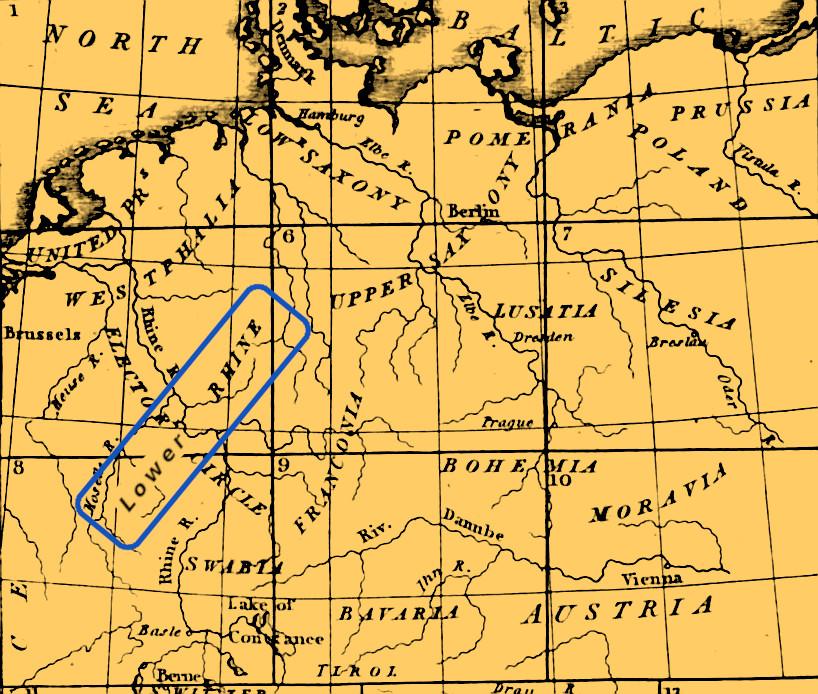

The countries belonging to this circle lie scattered along the Rhine, Mayn, Neckar, and Mosel. The latter rises in France, in the Vogesian mountains, on the borders of Alsace, and falls into the Rhine. The soil is in general very fruitful, and produces the best wine of any in Germany. In the lower palatinate most of the inhabitants are Lutherans or Calvinists, but in the other parts Catholics. The directing prince of this circle is the Elector of Mentz [Mainz]. The assemblies of the circle are held at Frankfort on the Mayn. It contains the following Provinces:
I. The dominions of the Elector of Mentz [Footnote: The Elector of Mentz is the primate and first elector in Germany. His possessions, besides those in the Lower Rhine, [2] are, part of the county of Königstein, in the Upper Rhine, and the county of Rieneck, in Franconia. Mentz was a bishopric before the time of Charles the Great. In the year 750 it was raised to an archbishopric]:
1. The archbishopric of Mentz, on the Rhine, at the mouth of the Mayn. The chief towns are,
Mentz, on the Rhine, the capital and residence of the Elector, with a Catholic University. Aschaffenburg, a fine town on the Mayn, with an electoral castle. Bingen, a small town, remarkable for the Cataract in the Rhine, near it, called the Bingerloch.
2. Eichsfeld, north-east of Hesse-Cassel, in Upper Saxony, in which are the towns of Heiligenstadt and Duderstadt.
3. The city of Erfurt with its territory, south-east of Eichsfeld, in Thuringia.
Erfurt, a large fortified town, inhabited chiefly by Lutherans, with an university, the professors of which are partly Lutherans, partly Catholics.
II. The archbishopric of Triers [Footnote: Triers was one of the most ancient bishoprics in Germany. It is not exactly known when it was made an archbishop’s see. The Archbishop of Triers is the second ecclesiastical elector. He possesses besides, in this circle, part of the county of Lower-Ysenburg], on the Mosel, produces a great quantity of wine. The principal places are,
Triers, the capital and residence of the Elector, one of the most ancient cities in
Germany, with a Catholic University. Coblentz, a fortified town, at the influx of the Mosel into the Rhine. Ehrenbreitstein, a fortification on a mountain near the Rhine, exactly opposite to Coblentz. Nieder Selters, or Selters, a village, in whose neighbourhood is a famous spring of mineral water, great quantities of which are exported.
IIl. Dominions of the Elector of Cologne [Footnote: The Archbishop of Cologne is the third spiritual elector. Cologne was raised to an archbishop’s see in 743]:
I. The archbishopric of Cologne, on the Rhine, north of the archbishopric of Triers; wherein is
Bonn, a fortified town on the Rhine, and the residence of the elector. Andernach, a town on the Rhine.
2. The dutchy of Westphalia, north-west of Hesse. Arensberg is the eapital of it.
3. The county of Recklinghausen, to the north-east of the archbishopric of Cologne, on the Lippe.
IV. The palatinate of the Rhine, or the Lower Palatinate (to distinguish it from the Upper Palatinate, in Bavaria). It lies on the Rhine and Neckar, and is exceedingly fertile in corn and wine. The chief towns are,
Heidelberg, on the Neckar, the capital. It has an university, the professors of which are partly Catholics, partly Calvinists.
Mannheim, a well-built town at the influx of the Neckar into the Rhine, the ancient residence of the electors of the palatinate.
V. The principality of Aremberg, to the west of the archbishopric of Cologne. It belongs to the Duke of Aremberg.
VI. The county of Lower-Ysenburg, north of the archbishopric of Triers, subject to the Elector of Triers, the Count of Wied-Runkel, and the Baron of Walderdorf.
VII. The burgravate of Rieneck, a small town on the Rhine, near Andernach, belonging to Count Zinzendorf.
VIII. The lordship of Beilstein, adjoining to the principality of Nassau. and subject to the Prince of Nassau-Diez.
Chap. XIV.
The Circle of Lower Saxony


It lies to the east of Westphalia, on the Elbe, Weser, Aller, and Leine. The Aller rises in the dutchy of Magdeburg, and runs into the Weser. The Leine rises in the Eichsfeld, and falls into the Aller. The breed of cattle is very good in almost all the provinces of this circle. Some parts produce a great deal of corn and flax, much wood, and likewise metals. The inhabitants are chiefly Lutherans. Here and there the Calvinists and Catholics enjoy likewise the free exercise of their religion. The directing princes of the circle are, the Elector of Brandenburg as Duke of Magdeburg, and the Elector of Hannover. The circular assemblies were usually held at Brunswick or Lüneburg. Since 1682 they have been discontinued.
The following countries belong to this circle:
I. The dominions of the Elector of Hannover.
(W. R. Shepherd, Historical Map of Central Europe about 1786 [1926]):
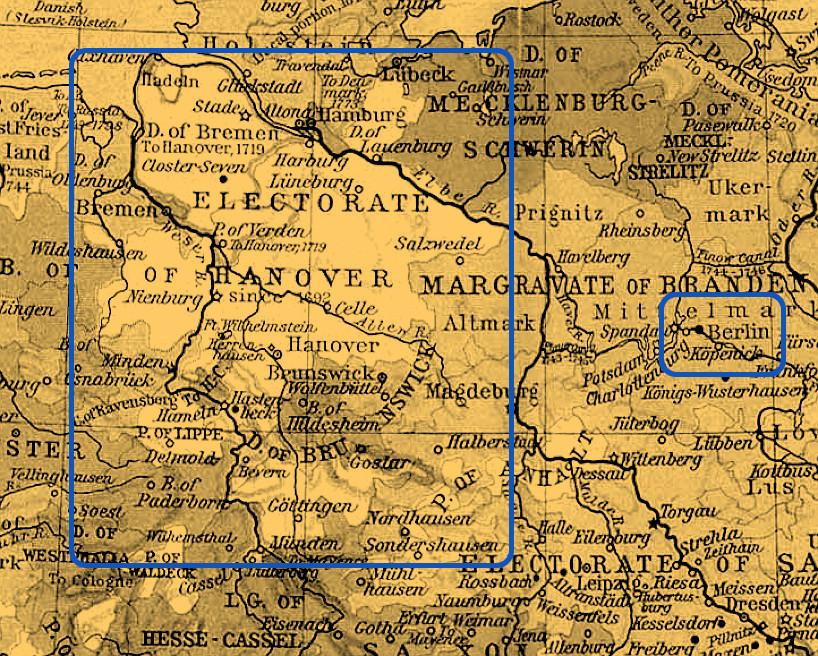
1. The dutchy of Bremen, on the North Sea, between the Elbe and the Weser, in which is Stade, a fortification on the Elbe.
2. The principality of Lüneburg, between the Elbe and Aller. Besides very fruitful arable and pasture land, it contains many sandy, waste, and swampy parts. The chief towns are,
Lüneburg, the capital. It is the great deposit of merchandise going to Hamburg and Lübeck, or coming from thence. Celle, a town on the Aller. Haarburg, on the Elbe.
3. The principality of Calenberg, south-west of Lüneburg, between the Weser and the Leine. The chief towns are,
Hannover, on the Leine, the capital of all the electoral dominions. Hameln, a fortified town on the Weser. Göttingen, on the Leine, with a Lutheran University. Münden, a town on the Weser.
4. The principality of Grubenhagen, south of Calenberg, on the Leine, chiefly upon the Harz mountains. [Footnote: The Harz is a very mountainous and woody district, about sixty miles long, and from twenty to twenty-five broad. The inhabitants chiefly subsist by working in the mines.] It contains some gold, much silver, copper, iron, and other minerals.
Einbeck is the capital. Clausthal, the chief town of the Harz.
5. The dutchy of Saxe-Lauenburg, to the north of Lüneburg, on the Elbe. The chief towns are,
Ratzeburg, a fortified town; part of which belongs to the principality of Ratzeburg. Lauenburg, a town on the Elbe.
II. Dominions of the Duke of Brunswick-Wolfenbüttel:
1. The principality of Wolfenbüttel, south of the principality of Lüneburg. The chief places are,
Brunswick, the capital, and residence of the duke. Wolfenbüttel, a fortified town. Helmstädt, a town with a Lutheran university.
2. The principality of Blankenburg, south of Wolfenbüttel, chiefly in the Harz mountains. Blankenburg is the capital. [Footnote: The principality of Wolfenbüttel is part of the ancient dutchy of Brunswick. The principality of Blankenburg was formerly a county, but in 1705 was raised to the rank of a principality, and in 1731 became subject to the Duke of Brunswick-Wolfenbüttel].
III. Dominions of the King of Prussia:

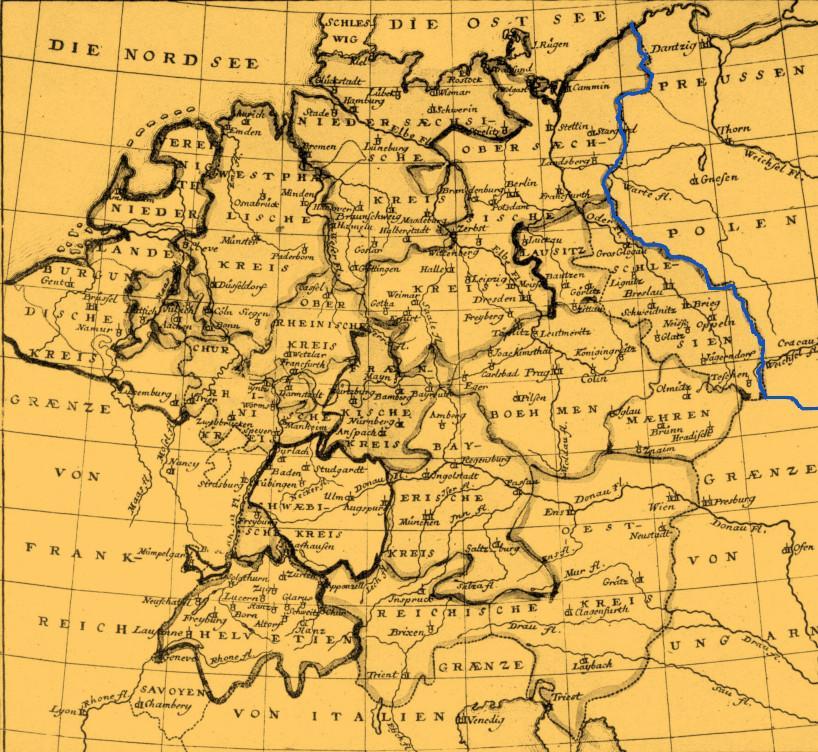
1. The dutchy of Magdeburg, south-east of Lüneburg, on the Elbe and Saale, produces great quantities of salt.
Magdeburg, on the Elbe, the capital, is strongly fortified, and carries on a great trade. Near this town is the Protestant monastery of Bergen, where in 1577, the Formula Concordiae was drawn up. Halle, a town on the Saale, with a Lutheran university, has very considerable salt springs. In the town of Glaucha, situated close under the walls of Magdeburg, is the famous orphan house, and royal paedagogium of Halle.
2. The principality of Halberstadt, west of Magdeburg.
Halberstadt is the capital.
IV. Dominions of the dukes of Mecklenburg:
1. The dutchy of Mecklenburg, on the Baltic Sea. It comprehends the two dutchies of Mecklenburg-Schwerin and Mecklenburg-Güstrow, which are divided into three circles, namely, Mecklenburg, Wenden, and Stargard. The former includes all Mecklenburg-Schwerin, and the two latter Meeklenburg-Güstrow. The chief towns are,
ln Mecklenburg-Schwerin:
Schwerin, the capital and ducal residence, on the sea of Schwerin. Wismar, a town on the Baltic, with a good harbour, which, together with several other places and districts, belong to the King of Sweden.
In Mecklenburg-Güstrow:
Neu-Strelitz, the residence of the duke; Rostock, a trading town on the Baltic, with a Lutheran University; Güstrow and New-Brandenburg.
2. The principality of Schwerin, between the dutchies of Mecklenburg-Schwerin and Mecklenburg-Güstrow; in which is
Bützow, a town with a Lutheran University.
3. The principality of Ratzeburg, between the dutchies of Saxe-Lauenburg and Mecklenburg-Schwerin.
V. Dominions of the King of Denmark:
1. The dutchy of Holstein [Footnote: Holstein was formerly a county. In the fifteenth century it was raised to the rank of a dutchy, comprehending the countries of Stormar, Ditmarsh, and Wagria. Since that time Holstein has partly been governed by the kings of Denmark, partly by its own dukes; till in 1773, upon the accession of a duke of Holstein to the Imperial throne of Ruffia, the ducal part of Holstein became subject to Russia, and was ceded to Denmark by that power in lieu of Oldenburg and Delmenhorst.], on the Elbe, the North Sea, and the Baltic. lt has a very fine breed of horses, and other cattle. The chief towns are,
Glücktstadt, a fortified town on the Elbe. Rendsburg, a fortified town on the Eyder, the boundary of the German Empire. Kiel, on the Baltic, has a good harbour, and a Lutheran university.
2. The lordship of Pinneberg, on the Elbe, near Hamburg; in which is Altona, a town on the Elbe, with a good trade and manufactures.
3. The county of Ranzau, between Holstein and Pinneberg.
VI. The bishoprics of Hildesheim and Lübeck:
1. The bishopric of Hildesheim, on the Leine, south of the principality of Lüneburg.
Hildesheim is the capital, and residence of the bishop.
2. The bishopric of Lübeck, surrounded by the dutchy of Holstein.
Eutin is the residence of the bishop.
VII. Six free Imperial Cities:
1. Hamburg, a famous trading city, at the mouth of the Elbe. It contains 112,000 inhabitants. 2. Lübeck, a trading town on the Baltic. In the district belonging to it lies Travemünde, a town on the Baltic. 3. Bremen, a trading town at the mouth of the Weser. 4. Gosslar, in the principality of Wolfenbüttel. The Duke of Brunswick is the patron of this city. 5. Nordhausen, in Upper Saxony, between the counties of Hohenstein and Stollberg, has an extensive corn trade. 6. Mühlhausen, in Upper Saxony, to the south of Nordhausen.
Chap. XV.
The Circle of Upper Saxony
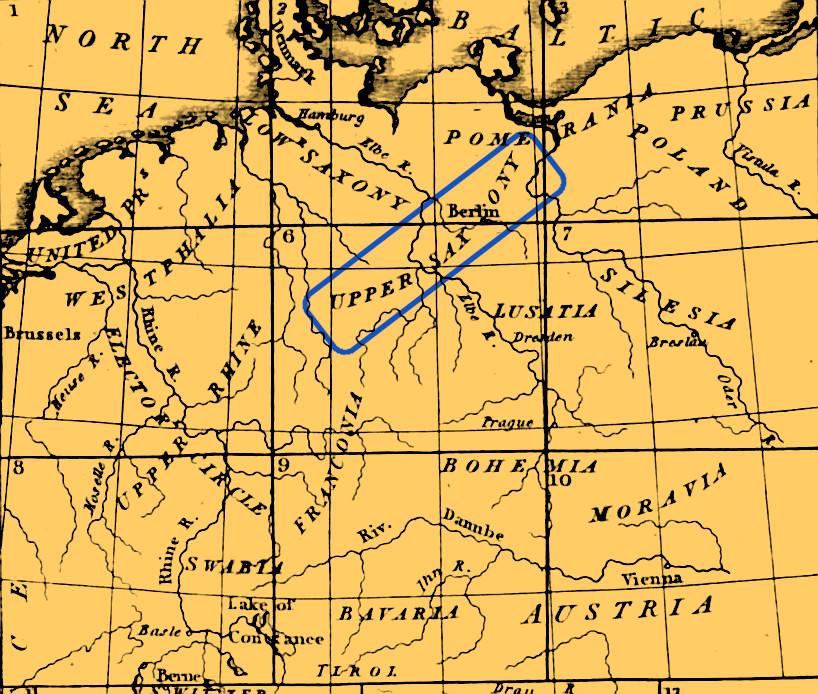

It lies to the south of Lower Saxony, on the Elbe, Oder, Saale, and Havel, the two latter of which fall into the Elbe. The Saale rises in the Fichtelberg, in Franconia; and the Havel, in Mecklenburg, in Lower Saxony. The southern part of Upper Saxony is mountainous, yields great quantities of corn and wine, has a fine breed of cattle, and many metals: the northern part is level, and contains many swampy and sandy, as well as fruitful parts. The inhabitants of this circle are principally Lutherans, partly Calvinists, and but very few Catholics. The directing prince of this circle is the Elector of Saxony. The circular assemblies were formerly held at Leipzig, but have long been laid aside.
I. Dominions of the Elector of Saxony.
They comprehend the dutchy of Saxony, the greater part of the margravate of Misnia, part of Voigtland, and the northern most half of the landgravate of Thuringia, the principality of Querfurt, the county of Barby (all of the above making seven circles), and the two bishoprics of Merseburg and Naumburg. All these countries are in general very fruitful, abounding in grain, wood, wine, metals, salt, &c. and have a good breed of cattle.
1. The electoral circle (or the dutchy of Saxony), with the county of Barby, in the midst of Upper Saxony, on the Elbe. The most remarkable towns are,
Wittenberg, on the Elbe, the capital of the electoral circle, with an university. The reformation was begun here by Martin Luther, in 1517. Barby, a town on the Elbe, in the county of Barby.
2. The circle of Thuringia. It comprehends part of the landgravate of Thuringia, on the Saale, and the principality of Querfurt, which lies partly in Thuringia, partly to the east of the electoral circle. The chief towns are,
Langelsalza, the capital. Weissenfels, a town on the Saale. Querfurt, the capital of the principality of Querfurt.
3. The circle of Misnia, south of the electoral circle on the Elbe, abounds in corn and wine. The chief towns are,
Dresden, on the Elbe, the capital of the electorate of Saxony, and residence of the elector. It is well fortified, one of the finest towns in Germany, and contains above 50,000 inhabitants. Near it, on the Elbe, stands the electoral castle of Pilnitz. Misnia, a town on the Elbe, remarkable for its porcelain. Königstein, a strong fortress on the Elbe. Torgau, on the Elbe.
4. The circle of Leipzig, west of Misnia. The chief towns are,
Leipzig, one of the most noted trading towns in Germany, which has three great annual fairs, with an university. The number of inhabitants amounts to above 40,000. Wurzen, the capital of an ancient bishopric of that name.
5. The circle of Erzgebirge, south of Misnia, has mines of silver, copper, tin, lead, &c.
Freyberg is the capital.
6. The circle of Voigtland, to the west of Erzgebirge. It comprehends chiefly, the electoral part of Voigtland, and part of the margravate of Misnia.
Plauen is the capital.
7. The circle of Neustädt, north of Voigtland, the chief town of which is Neustädt, on the Orla.
8. The bishopric of Merseburg, west of the circle of Leipzig, on the Saale; the chief towns of which are,
Merseburg, on the Saale; and Lauchstädt, a small place, with a spring of mineral water.
9. The bishopric of Naumburg-Zeiz, south of Merseburg, on the Saale and Elster. The chief towns are,
Naumburg, the capital, which has a noted fair. Zeiz, a town on the Elster.
II. The margravate of Brandenburg.
[W. R. Shepherd, Historical Map of Central Europe about 1786 (1926)]
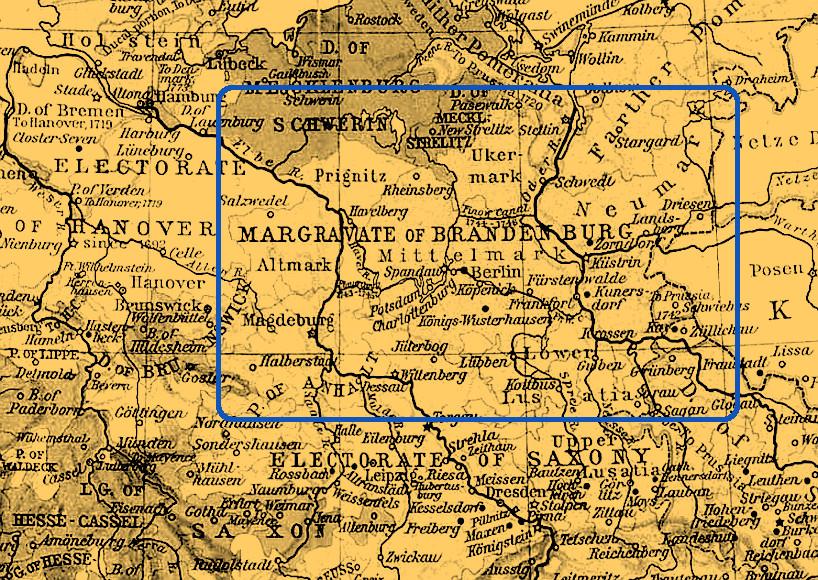
It lies on the Elbe, the Oder, the Havel, and Spree. The Spree rises in Lusatia, and runs into the Havel. The Oder is here joined to the Spree by the canal of Frederic-William, and to the Havel by the Finow canal. The breed of cattle, and particularly of sheep, is very good, and a considerable quantity of silk is manufactured. The country is divided into five Provinces or marks; namely, the Middle Mark, the Old Mark, Priegniz, Ucker Mark, and New Mark.
1. The Middle Mark, north of the electoral circle of Saxony, on the Havel and Spree. The principal towns are,
2. The Old Mark, to the west of the Middle Mark, on the Elbe.
Stendal is the capital.
3. Priegniz, north-west of the Middle Mark, on the Elbe, in which is Perlberg, the capital.
4. The Ucker Mark, north of the Middle Mark, on the Oder.
Prenzlow is the chief town.
5. New Mark, east of the Middle and Ucker Mark, on the Oder and Warte, the latter of which rises in Poland, and falls into the Oder at Cüstrin. To the New Mark belong also the dutchy of Crossen, in Silesia, and the Elector of Brandenburg’s part of Lower Lusatia. The principal places are,
Cüstrin, a fortification on the Oder, the chief town of the New Mark. Crossen, on the Oder, in the dutchy of Croffen. Cotbus, a town in Lower Lusatia, on the Spree. Sonnenburg, a small town in the New Mark, the principal place in the mastership of the knights of Sonnenburg, or bailiwick of Brandenburg.
III. The dutchy of Pomerania, on the Baltic, on both sides of the Oder.
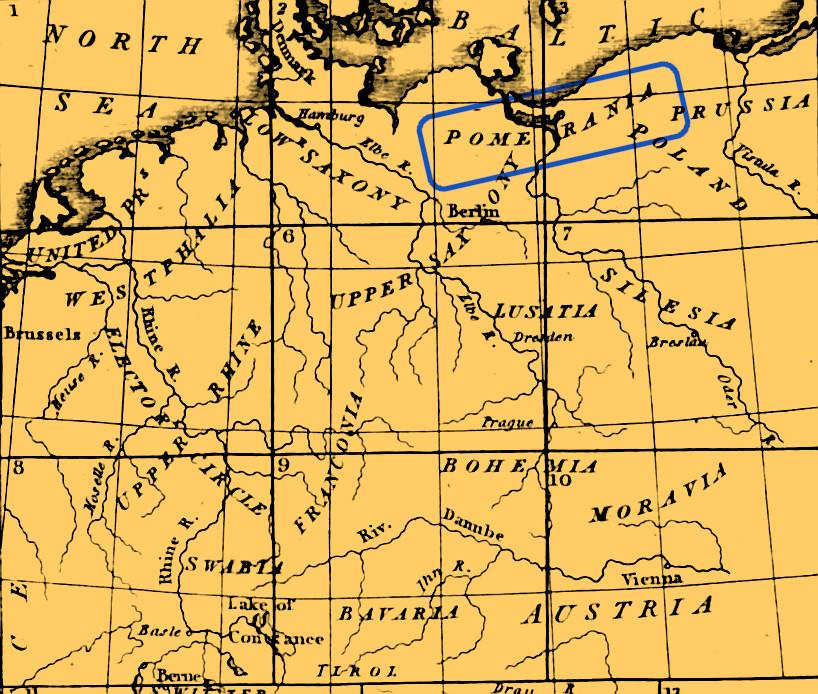
It has a fine breed of cattle, and abounds in wood. It is divided into Hither and Farther Pomerania.
1. Hither Pomerania, west of the Oder. The islands of Rügen, Usedom, and Wollin, lying on the Baltic, belong to it. The chief towns are,
In the Prussian part:
Stettin, on the Oder, the capital of all Pomerania, which is well fortified, carries on a great trade, and contains 20,000 inhabitants. Anklam, a trading town.
In the Swedish part:
Stralsund, the capital, on the Baltic, is well fortified, and has a great trade. Greifswald, a town with an University, near the Baltic.
2. Farther Pomerania, east of the Oder. Here and there, in this part of Pomerania, particularly in the district of Cassuben, the Vandal language is spoken.
Stargard is the chief town. Colberg and Camin are the most remarkable places, in the principality of Camin, belonging to Hither Pomerania.
IV. Dominions of the dukes of Saxe.
[Footnote: The dukes of Saxe of the line of Ernest are divided into two principal branches; namely, Weimar and Gotha: Gotha is subdivided into that of Gotha, Meinungen, Hildburghansen, and Coburg-Saalfeld. The Duke of Weimar possesses the principalities of Weimar and Eisenach; to the Duke of Gotha belong the principality of Gotha, the greater part of the principality of Altenburg (the whole of which is under his jurisdiction), and part of the principality of Coburg: to the dukes of Saxe-Meinungcn, part of the principality of Coburg, and part of the county of Henneberg, in Franconia: to the Duke of Hildburghausen, the greater part of the principality of Coburg: and to the Duke of Coburg-Saalfeld, part of Coburg, and part of Altenburg. The silver mines, the university, and the court of justice at Jena, belong to all the five dukes in common. The principalities of Weimar and Eisenach, and the greater part of Gotha, lie in Thuringia, but Coburg in Franconia. Altenburg is a part of the margravate of Misnia. The dukes of Weimar, Gotha, Meinungen, and Hildburghausen, have likewise a part of the princely county of Henneberg, in Franconia.]
They comprehend part of the landgravate of Thuringia, part of the margravate of Misnia, and that part of Franconia belonging to the circle of Upper Saxony, abounding in corn and cattle; producing some wine, and a great quantity of wood and metals. They consist of the five following principalities:
1. The principality of Weimar, west of the Saale. The chief towns are, Weimar, the residence of the duke. Jena, a town on the Saale, with an university.
2. The principality of Eisenach, west of Weimar.
Eisenach is the capital.
3. The principality of Coburg, south of Weimar. The chief towns are, Coburg, the residence of the Duke of Coburg-Saalfeld. Hildburghausen, on the Werra, the residence of the Duke of Hildburghausen.
4. The principality of Gotha, east of Eisenach.
Gotha, the capital, and residence of the duke, is one of the finest towns in
Thuringia.
5. The principality of Altenburg, east of Weimar, on the Saale.
The principal towns are,
Altenburg, the capital. Saalfeld, a town on the Saale, the capital of the division belonging to Coburg.
V. The principality of Anhalt, north-west of the electorate of Saxony, on the Elbe and Saale.
The chief towns and residences of the princes are, Dessau, a town on the Mulde, near the Elbe. Bernburg, on the Saale. Zerbst, where is a gymnasium, belonging to all the princes of Anhalt in common; and Köthen.
VI. The principality of Schwarzburg.
It is part of Thuringia, and consists of the upper and lower principality. The former lies south, and the latter north of the principality of Gotha. The chief towns are,
Sondershausen and Rudelstadt, the residences of the princes.
VII. Four counties:
1. Mannsfeld, south of the principality of Anhalt. The chief towns are, Eisleben a town in the Saxon division. Mannsfeld, in the Prussian part.
2. Stollberg, west of Mannsfeld, in Thuringia.
Stollberg is the chief town, and residence of the Count of Stollberg-Stollberg.
3. Wernigerode, north-west of the principality of Anhalt, chiefly on the Harz mountains. The most remarkable town is
Wernigerode, the residence of the Count of Stollberg-Wernigerode.
4. Hohenstein, north of the principality of Schwarzburg. The chief town is Ilefeld, a small place in the Hannoverian division.
VIII. The abbey of Quedlinburgh.
On the borders of Lower Saxony, adjoining to the principality of Halberstadt, the capital of which is Quedlinburgh.
IX. The following lordships:
1. The lordships of the princes and counts Reuss. They comprehend part of Voigtland. The chief towns and places of residence are,
Gräz, Gera, Schleiz, Lobenstein, and the village of Ebersdorf.
2. The lordships of the counts of Schönburg. They border on the circles of Erzgebirge and Leipzig, in the electorate of Saxony, and are under the jurisdiction of the elector.
Glauchau is the chief town.
3. The lordships of Lora and Klettenberg. They belong to the King of Prussia, and are incorporated with the principality of Halberstadt. They are also called the county of Hohenstein, but must not be confounded with the one before mentioned.
Elrich is the capital.
Notes
[*] Jakob Gottlieb Isaak Boetticher, A Geographical, historical, and political Description of the Empire of Germany, Holland, the Netherlands, Switzerland, Prussia, Italy, Sicily, Corsica, and Sardinia, trans. from the German (London 1800), 41–48, 71–81; the frontispiece (“Reduced Index to Chauchard’s Maps”) is reproduced as the first map here and in subsequent sections with indications of the various “circles” (Kreise, sg. Kreis) to provide readers with a quick geographical orientation.
The map of Germany in 1774 following each map of 1800 provides an essentially identical but more detailed look at the area that constituted the “German” part of the Holy Roman Empire (Reich) of the German Nation during most of Caroline’s life. Its changing political structure during the late 1790s and esp. after 1803 as a result of the Napoleonic Wars is documented in this correspondence not least because those changes profoundly affected Caroline’s life (Daniel Nikolaus Chodowiecki, provides Der Tischler mit seinen Gesellen, Kupfersammlung zu J[ohann] B[ernhard] Basedows Elementarwerke für die Jugend und ihre Freunde: Erste Lieferung in 53 Tafeln. Zweyte Lieferung in 47 Tafeln von L bis XCVI [Leipzig, Dessau, Berlin 1774], plate xl).
Boetticher’s book provides a comprehensive account of how Germany was constituted and viewed ca. 1800. Note: Boetticher understands the Upper and Lower Rhine differently than do modern geographers, who generally also include an area called the Middle Rhine. Boetticher is thinking not least of principalities in some designations, and, oddly, does not include the designation “Lower Rhine” in his map, a designation added here for which he seems to be thinking of the Electoral Circle along the Rhine. Boetticher’s map, incidentally, is a simplified version of the frontispiece map in Captain Chauchard and Samuel John Neele, A General Map of the Empire of Germany, Holland, the Netherlands, Switzerland, the Grisons, Italy, Sicily, Corsica, and Sardinia (London 1800), whose full version includes in considerably more detail the towns and principalities Boetticher mentions.
Caroline spent much of her life in Lower and Upper Saxony, especially during the period covered by volume 1 of this edition and by volume 2 to 1803; also in volume 1, her time in Mainz took her to the circle of the Lower Rhine (Boetticher’s Electoral Circle). Caroline would wed Schelling in Murrhardt, in Swabia, through which they would do at least some traveling. They would then move to Würzburg, in Franconia, and finally to Munich, in Bavaria. She would contract her final illness and pass away in Maulbronn, in Swabia, where she is also buried.
The chapter on the system of imperial governance provides an account of the political hierarchies at the time, including ecclesiastical elements, that on the specific territorial circles an account of the territorial hierarchies.
Readers can read these chapters selectively or search place names on the page, remembering that some names were spelled differently at the time in England.
Illustration of the imperial diet in 1640, i.e., before it became a “perpetual diet”: anonymous, Der Reichstag in Regensburg 1640 (1640); Herzog August Bibliothek; Museums./Signatur Graph. C: 180. Illustration of the “perpetual diet”: anonymous engraving, Eigentlicher Abriß der Reichstags Solemnnitat so den 10/20 Ianuarÿ Anno 1663 in Regensburg . . . (1663). Back.
[1] Concerning the process and ceremonies involved in the election of the German emperor in Frankfurt (omitted here), see supplementary appendix 113.2. Back.
[2] What Boetticher is referring as the “Lower Rhine” is what on Chauchard was originally “Upper Rhine” (emended on the map of 1800 for clarity). The entire area, as shown on the map of 1774, actually encompasses the Upper Rhine ([Der] Oberrheinische Kreis) and Electoral Rhine ([Der] Churrheinische Kreis):
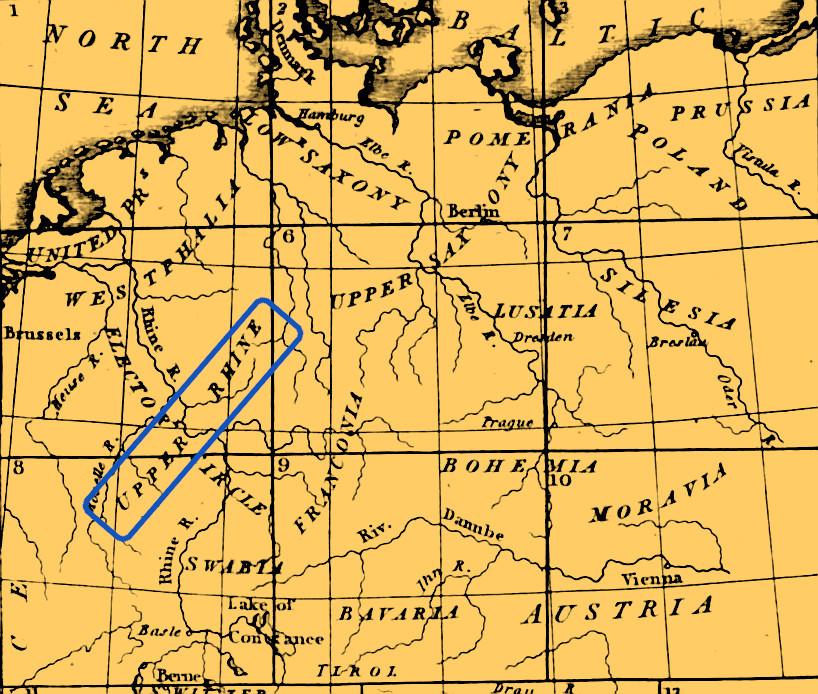
Translation © 2014 Doug Stott
